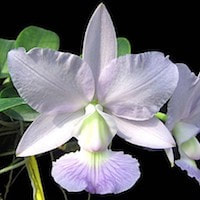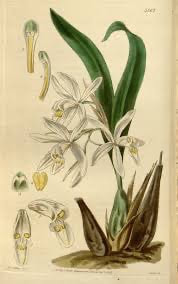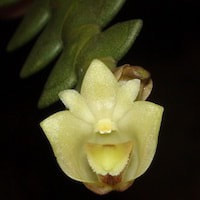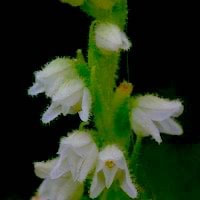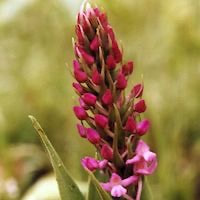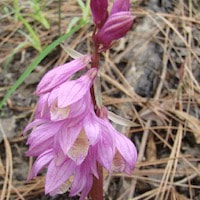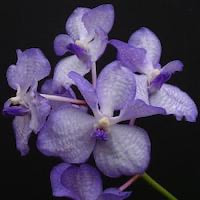Discover the Healing Power of Orchid Fragrance Blend
The fragrance blend contains scented notes from various orchid species, including Cattleya Walkeriana, which is not native to the region but was highly admired during a 2017 show at Gardens by the Bay. This orchid species, also known as the "Queen of the Brazilian savannah," originates from the Brazilian central plateau and surrounding areas. Despite its non-native status, it has been added to the collection due to its alluring cinnamon and vanilla fragrance, which it often passes on to its hybrid offspring.
Among the therapeutic orchid notes, Coelogyne punctulata Lindl. is utilized in northern India to treat wounds and burns, while in Vietnam, it is used to alleviate dry coughs and bleeding caused by trauma. Dendrobium leonis (Lindl.) Rchb.f., referred to as "Uang takhap yai" or "kang pla" in Thai, emits a delightful vanilla scent and is employed in Thailand to address headaches.
Another orchid, Gymnadenia orchidis Lindl. Syn. Gymnadenia conopsea (L.) R.Br. var. yunnanensis Schltr., grows in various regions, including India and Nepal, and is esteemed for its medicinal properties. In Nepal, the powdered pseudobulbs are applied to cuts and wounds, while in China, it is valued similarly to ginseng and is utilized for various conditions such as coughs, impotence, and traumatic injuries.
Nervilia gammieana (Hook.f.) Pfitzer. Syn. Pogonia gammiena Hook f., found in Pakistan, Nepal, and the Indian Himalayas, contains alkaloids and has its tubers used as salep. Vanda coerulea Griff. ex Lindl., known as "Dahuawandai Lan" or "Large Vanda," forms the basis of many blue and red Vanda hybrids. Although it was previously endangered due to overcollection, it is now thriving in the wild, particularly in Myanmar and northern Thailand.
The scent of Vanda coerulea is a delightful blend of white chocolate, dark chocolate, violet, fresh white musk, Cepes, black pepper, Calamus, and Tonka Beans, making it a prized addition to floral fragrances. Moreover, phytochemicals found in this species have exhibited antioxidant properties and the potential to protect the skin from UV damage.
These orchid notes, with their unique scents and therapeutic properties, enrich the aromatic experience and bring forth the natural beauty of these exquisite flowers. The intriguing combination of various scent notes adds complexity and allure to the final fragrance blend.
Among the therapeutic orchid notes, Coelogyne punctulata Lindl. is utilized in northern India to treat wounds and burns, while in Vietnam, it is used to alleviate dry coughs and bleeding caused by trauma. Dendrobium leonis (Lindl.) Rchb.f., referred to as "Uang takhap yai" or "kang pla" in Thai, emits a delightful vanilla scent and is employed in Thailand to address headaches.
Another orchid, Gymnadenia orchidis Lindl. Syn. Gymnadenia conopsea (L.) R.Br. var. yunnanensis Schltr., grows in various regions, including India and Nepal, and is esteemed for its medicinal properties. In Nepal, the powdered pseudobulbs are applied to cuts and wounds, while in China, it is valued similarly to ginseng and is utilized for various conditions such as coughs, impotence, and traumatic injuries.
Nervilia gammieana (Hook.f.) Pfitzer. Syn. Pogonia gammiena Hook f., found in Pakistan, Nepal, and the Indian Himalayas, contains alkaloids and has its tubers used as salep. Vanda coerulea Griff. ex Lindl., known as "Dahuawandai Lan" or "Large Vanda," forms the basis of many blue and red Vanda hybrids. Although it was previously endangered due to overcollection, it is now thriving in the wild, particularly in Myanmar and northern Thailand.
The scent of Vanda coerulea is a delightful blend of white chocolate, dark chocolate, violet, fresh white musk, Cepes, black pepper, Calamus, and Tonka Beans, making it a prized addition to floral fragrances. Moreover, phytochemicals found in this species have exhibited antioxidant properties and the potential to protect the skin from UV damage.
These orchid notes, with their unique scents and therapeutic properties, enrich the aromatic experience and bring forth the natural beauty of these exquisite flowers. The intriguing combination of various scent notes adds complexity and allure to the final fragrance blend.
Other fragrance oils- Oriental 1, Oriental 2, Oriental 3, Oriental 4, Oriental 5, Oriental 6, Oriental 7, Oriental 8, Oriental 9, Oriental 10, Oriental 11, Oriental 12
Download the guided mediation that works best with this Orchid fragrance oil
| women_oriental_essential_oil_orchi_00007.mp3 | |
| File Size: | 41640 kb |
| File Type: | mp3 |
Exploring Cattleya Walkeriana: The Queen of Brazilian Savanna Orchids
Contains Scented Notes of following in various proportions:
Native Singaporean Orchid notes: Cattleya Walkeriana
|
Cattleya Walkeriana - Used in Oriental 7 (Women) for Team building Perfume workshop
Cattleya Walkeriana, used in Oriental 7 (Women) for a Team building Perfume workshop, is a non-native variety that gained immense popularity during the 2017 show at Gardens by the Bay. As a result of its widespread admiration, it has been added to the permanent collection. Often referred to as the "Queen of the Brazilian savannah," this magnificent orchid species thrives in the heartland of the Brazilian central plateau and its surrounding regions. The plants are relatively small and can be found as epiphytes, lithophytes, and even semi-terrestrial in leaf litter. For more than three decades, the author of the perfume has dedicated significant efforts in collaboration with the Brazilian Ministry of the Environment (IBAMA) to protect and study the diverse orchid flora of Brazil. Apart from its captivating beauty, Cattleya Walkeriana is known for its enchanting fragrance, evoking a soothing blend of cinnamon and vanilla. Notably, this delightful scent is often inherited by its offspring, making it a desirable choice for creating hybrid orchids with similarly alluring fragrance notes. In the Team building Perfume workshop, Cattleya Walkeriana adds a touch of elegance and relaxation, creating a unique olfactory experience that resonates with the essence of the Brazilian savannah. Its presence in the fragrance blend enhances the overall aroma, infusing it with the natural charm and warmth of this exquisite orchid species. |
Therapeutic Orchid notes:
|
Coelogyne punctulata Lindl.
Coelogyne punctulata Lindl., valued not only for its medicinal properties but also for its unique scent notes, has been utilized for various therapeutic purposes in different regions. The pseudobulbs of Coelogyne punctulata are dried and processed into a fine powder, which is then employed in northern India as a remedy for wounds and burns. The powder's medicinal properties are known to aid in the healing process and provide relief from injuries. In Vietnam, Coelogyne punctulata is utilized to address dry coughs and bleeding resulting from trauma. The plant's specific components contribute to its effectiveness in managing these conditions, making it a valuable resource in traditional medicine practices. Apart from its therapeutic uses, Coelogyne punctulata is also appreciated for its aromatic profile. The scent notes of this orchid species are described as delicate and pleasant, with hints of floral and earthy undertones. When utilized in fragrance compositions or aromatherapy, its alluring fragrance can create a calming and soothing atmosphere. The combination of its therapeutic properties and charming scent notes makes Coelogyne punctulata a versatile and valuable ingredient in various traditional and contemporary practices. |
|
Dendrobium leonis (Lindl.) Rchb.f.
Thai Names: Uang takhap yai, kang pla Dendrobium leonis (Lindl.) Rchb.f., known for its distinct scent notes, emits a pleasant fragrance reminiscent of vanilla. The flowers of Dendrobium leonis are relatively small, measuring about 1 cm in diameter. They are yellow in color and grow individually on the plant. When in bloom, these flowers exude a delightful vanilla-like aroma that adds to their charm. In addition to its aromatic qualities, Dendrobium leonis is also utilized for its therapeutic properties. In Thailand, the entire plant is utilized as a herbal remedy to address headaches. Traditional practices in Thai medicine make use of various parts of the plant to provide relief and alleviate discomfort associated with headaches. The combination of its appealing fragrance and medicinal applications makes Dendrobium leonis a valuable and multifunctional plant in different cultural contexts, where it is appreciated both for its scent and its potential to promote well-being. |
|
Goodyera R. Br.
Chinese name: Banye Lan Chinese medicinal name: Banyelan Japanese name: Shusu Ran Goodyera R. Br., commonly known as "rattlesnake plantain," is a genus of orchids with interesting scent notes. Although specific information about the fragrance of Goodyera R. Br. is not readily available in the provided research, it is essential to note that orchids, in general, can have a diverse range of scents. Some orchids produce pleasant and sweet-smelling fragrances, while others may emit more subtle or even unpleasant odors. The scent of orchids can vary greatly between species and even among individual plants within a species. As a terrestrial orchid, Goodyera R. Br. is known to have a mutualistic relationship with specific groups of fungi, meaning they rely on these fungi for their growth and survival. This dependence on fungi for nutrient acquisition is common among many orchid species, and it plays a crucial role in their existence and ability to thrive in various ecosystems. While the exact scent notes of Goodyera R. Br. remain unspecified, it is important to recognize the ecological significance of these orchids in their interaction with fungi and their contribution to the biodiversity of their respective habitats. |
|
Gymnadenia orchidis Lindl. Syn. Gymnadenia conopsea (L.) R.Br. var. yunnanensis Schltr.
Chinese names: Shouzhangshen (name also refers to Gymnadenia crassinervis Finet). Xinanshoushen (southwest hand ginseng), Xinanshouzhangshen (southwest hand palm ginseng) Indian names: Salam panja, Salam punja, Salep Nepali names: Hati Jara; Panch aunle (“five fingers”, referring to the root) in Nepali; Ongbu lakpa (Sherpa) Gymnadenia orchidis Lindl. is a terrestrial orchid known for its fragrant scent and its use in traditional herbal medicine in various regions. The orchid is found in thickets and forests along valleys at altitudes ranging from 2400 to 4000 meters. It requires a period of chilling to stimulate seed germination, and green pod culture has been successful in vitro. In terms of herbal usage, Gymnadenia orchidis has a significant role in traditional medicine. In India, it is believed to have aphrodisiac properties, and pseudobulb powder is applied to cuts and wounds in Nepal. The decoction of the pseudobulbs is taken moderately three times a day to relieve stomach ache, liver disorders, and urinary disorders. Moreover, Gymnadenia orchidis enjoys a wide application in Chinese herbal medicine, similar to ginseng. It is used to treat coughs caused by weak lungs, impotence, other forms of sexual dysfunction, discharge, traumatic injuries, thrombosis, chronic hepatitis, and failure of lactation. The scent of Gymnadenia orchidis is described as fragrant and works well in floral scents. It contains aromatic compounds such as benzyl acetate, benzyl benzoate, methyl eugenol, eugenol, elemicine, benzyl alcohol, cinnamic alcohol, and trace amounts of phenylethylalcohol, phenylethylacetate, and (Z)-3-hexenol. These compounds contribute to the orchid's pleasing fragrance and make it an attractive addition to perfumes and floral scented products. |
|
Nervilia gammieana (Hook.f.) Pfitzer. Syn. Pogonia gammiena Hook f.
Indian name: Shankhaluka Nervilia gammieana (Hook.f.) Pfitzer, also known as Pogonia gammiena Hook.f., is an orchid species found in Pakistan, Nepal, and the Indian Himalayas. It is typically found at elevations of 600–800 meters in Garhwal and pine forests in north-east India. In terms of phytochemistry, Nervilia gammieana contains alkaloids, which are bioactive compounds with potential medicinal properties. Herbal usage of Nervilia gammieana involves the use of its tubers as "salep." Salep is a starchy, flour-like substance obtained from the dried tubers of certain orchid species. In traditional medicine, salep has been used as a remedy for various ailments, and it is often employed as a soothing drink to alleviate respiratory and digestive issues. While specific scent notes of Nervilia gammieana are not explicitly mentioned in the available research, it is worth noting that orchids, in general, can produce diverse and captivating scents. Some orchid species are known for their floral, sweet, or even spicy fragrances. The aromatic profile of Nervilia gammieana may vary and could potentially contribute to its appeal in various cultural practices or traditional herbal uses. |
|
Vanda coerulea Griff. ex Lindl.
Chinese name: Dahuawandai Lan (big flower ten thousand generation orchid, Large Vanda) Thai name: Fa Mui (in the north), Pho don ya, Pho thong (Karen Mae Hong Son) Myanmar Name: Moe lone hmine Indian name (Tirap District, Arunachal Pradesh): Rangpu Vanda coerulea Griff. ex Lindl., commonly known as the Blue Vanda or Big-flower Ten Thousand Generation Orchid, is a notable orchid species with several cultural associations and medicinal uses. Scent notes specific to Vanda coerulea are not explicitly mentioned in the available research. However, it's important to note that orchids, including Vanda species, are renowned for their diverse and captivating fragrances. Some orchids produce floral, sweet, or even spicy scents that contribute to their allure. In various regions, Vanda coerulea holds cultural significance and different names:
Phytochemistry studies have identified various compounds present in Vanda coerulea, including phytosterols, terpenoids, carbohydrates, and stilbenoids. Notably, imbricatin, methoxycoelonin, and gigantol from the orchid have shown antioxidant properties and inhibited COX-2 production and activity in ultraviolet-irradiated skin cells. These findings suggest potential protective effects against harmful effects from sunlight and pollution. Additionally, Vanda coerulea has been used for various herbal remedies:
Overall, Vanda coerulea's unique characteristics, cultural significance, and potential medicinal properties make it a cherished and valued species in various regions, contributing to its status as a sought-after and protected orchid species. |
Other scent note
Top of white chocolate, dark chocolate, violet, fresh white musk, Cepes, black pepper, Calamus, Tonka Beans
Scentopia Library Reference ingredient
Moon Flower - Check details at Scentopia's scent library
Join Scentopia's wonderful orchid scent crafting, fragrance tour, bridal shower or corporate team building which includes perfume making onsite and offsite, beach activities and more. We also serve primary school learning journey, secondary students and pupil on industrial excursions. Know more about our orchids perfume bar or therapeutic orchid scents and other wellness aromas. Conatct Perfume workshop or book a scent crafting session here.
